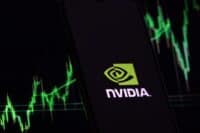

Many see semiconductor trends as leading indicators of technology and broader electronics demand. In a wider sense, semiconductor and tech stocks may be leading indicators for the economy and markets in general. Although markets have backed off recently, with Chinese trade talks in focus, in semiconductors especially, there is now room to run higher.
If any industry is prone to cyclicality it is the semiconductors, and that trend has been in place for going on 30 years. While the long-term outlook remains reasonably bright, the near term may be challenging.
On one hand, the semiconductor segment within technology has performed quite well in 2019. Many of these stocks may be still down considerably from their highs of 2018, but the sharp recovery in 2019 has vaulted them higher than the already-high stock market gains.
However, the prospect of a Chinese trade war could severely hurt U.S. semiconductor firms. These suppliers have a relatively high “ship-to” revenue exposure to China. This high exposure to China puts the semiconductor industry at greater risk to the escalation in the U.S.-China trade war than many other segments of technology.
To mitigate this risk and concerns about picking the winners or the losers within the industry, exchange-traded funds offer a sampling and exposure to this market without an all-or-none risk in any single company’s stock. As the saying goes: “There’s an ETF for that strategy.” ETF Database has collected much of the information about these ETFs, among others, and made it easily accessible for those looking to get into the game.
Investors can use a number of ETFs to invest in the volatile semiconductor industry. As you will see, the top semiconductor ETFs are all constructed with different leaders and components dominating the returns and focus of each one.
iShares PHLX Semiconductor ETF (NASDAQ: SOXX) has been around since July 2001, and it aims to track the PHLX Semiconductor Sector Index. This fund seeks to track the investment results of an index composed of U.S. equities in the semiconductor sector. Note that this is the largest semiconductor ETF, with $1.296 billion in assets under management. Its overall expense ratio is 0.47%, and it has traded up about 26% so far in 2019. This ETF has a total of 30 holdings. The top 10 holdings include mostly large-cap domestic semiconductor companies:
- Qualcomm (11.18%)
- Nvidia (8.13%)
- Broadcom (8.01%)
- Texas Instruments (7.72%)
- Intel (6.68%)
- Lam Research (4.08%)
- Advanced Micro Devices (4.07%)
- NXP Semiconductors (4.01%)
- Applied Materials (3.98%)
- Taiwan Semiconductors (3.89%)
VanEck Vectors Semiconductor ETF (NYSEARCA: SMH) has been around since December 2011 and aims to track the MVIS US Listed Semiconductor 25 Index. This fund seeks to track the overall performance of companies involved in semiconductor production and equipment. It has $994 million in assets under management. Its overall expense ratio is 0.35%, and it has traded up 25% so far in 2019. This fund has a total of 25 holdings. The top 10 holdings include a handful of large-cap U.S. semiconductors:
- Intel (11.94%)
- Taiwan Semiconductor (9.39%)
- Qualcomm (6.90%)
- Texas Instruments (5.82%)
- Nvidia (5.70%)
- Broadcom (5.21%)
- ASML (5.06%)
- Applied Materials (4.58%)
- Lam Research (4.54%)
- NXP Semiconductors (4.54%)
SPDR S&P Semiconductor ETF (NYSEARCA: XSD) has been around since February 2006 and aims to track the S&P Semiconductor Select Index. The fund seeks to provide exposure to the semiconductors segment of the S&P TMI, which comprises the Semiconductors sub-industry. It has $373 million in assets under management, its overall expense ratio is 0.35% and it was last seen trading up 27% so far in 2019. This ETF has a total of 34 holdings. Its top 10 holdings include mostly domestic semiconductor firms:
- Qualcomm (4.76%)
- Silicon Laboratories (4.04%)
- Marvell Tech (3.96%)
- Cree (3.76%)
- Advanced Micro Devices (3.71%)
- Broadcom (3.56%)
- First Solar (3.56%)
- Nvidia (3.56%)
- Cirrus Logic (3.51%)
- Microchip Technology (3.47%)
Invesco Dynamic Semiconductors ETF (NYSEARCA: PSI) has been around since June 2005. It aims to track the Dynamic Semiconductors Intellidex Index. This ETF seeks to track companies that are principally engaged in the manufacture of semiconductors. It was last seen to have $189.4 million in assets under management. Its overall expense ratio is 0.61%, and it has traded up 24% so far in 2019. This fund has a total of 29 holdings. The top 10 holdings include mostly domestic semiconductor firms:
- Qualcomm (7.70%)
- Lam Research (5.43%)
- Broadcom (5.31%)
- Analog Devices (5.17%)
- Texas Instruments (5.17%)
- Micron (4.74%)
- Xilinx (4.72%)
- Intel (4.65%)
- Cree (3.26%)
- Ambarella (3.22%)
Essential Tips for Investing: Sponsored
A financial advisor can help you understand the advantages and disadvantages of investment properties. Finding a qualified financial advisor doesn’t have to be hard. SmartAsset’s free tool matches you with up to three financial advisors who serve your area, and you can interview your advisor matches at no cost to decide which one is right for you. If you’re ready to find an advisor who can help you achieve your financial goals, get started now.
Investing in real estate can diversify your portfolio. But expanding your horizons may add additional costs. If you’re an investor looking to minimize expenses, consider checking out online brokerages. They often offer low investment fees, helping you maximize your profit.
Thank you for reading! Have some feedback for us?
Contact the 24/7 Wall St. editorial team.
 24/7 Wall St.
24/7 Wall St.


